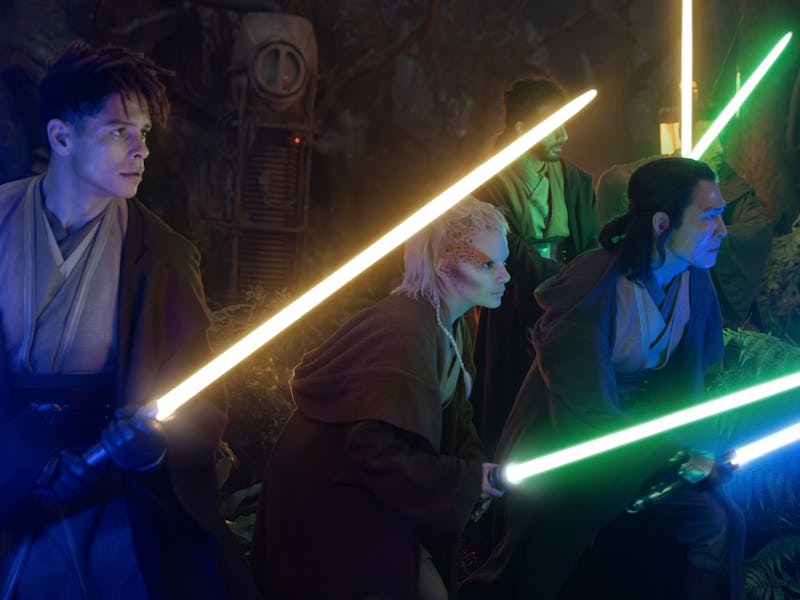The Acolyte Just Completely Rewrote Lightsaber Canon
Wait, you’re supposed to do what with a lightsaber?

When Obi-Wan Kenobi told Luke that lightsabers aren’t as clumsy or random as blasters, he forgot to mention one other thing: If you bust out a lightsaber in most contexts, you have to be ready to turn that thing into a murder stick. This apparently doesn’t apply to instances of practice or using your lightsaber as a flashlight, but in The Acolyte, we’ve got a new layer of Star Wars lore that makes fighting with this elegant weapon not exactly as civilized as we were led to believe.
In the very first scene of The Acolyte, as Jedi Master Indara (Carrie-Anne Moss) battles Mae (Amandla Stenberg), we hear a lightsaber rule that gives Indara pause. It might give longtime Star Wars aficionados pause, too. Is this really the way Jedi are supposed to think about their famous weapons? Spoilers ahead.
As much has been written about Jedi lore, the rules are slippery and have reached fans all out of order. What applied in one era of Jedi might not be true a few centuries later, and once you throw in all the pre-2014 comics and novels that are now non-canon, it’s easy to understand why we’re often confused about various Jedi codes of conduct, Force powers, and fashion choices.
Lightsabers are a good microcosm of just how much Star Wars canon has changed in a short time. Before 2016, most Star Wars fans assumed red lightsabers were red because of a red crystal, or, as more commonly suggested in the old Expanded Universe material, that the crystal was synthetic as opposed to the natural ones favored by the Jedi. But then, in the canon novel Ahsoka, it was revealed that Sith lightsaber crystals go through an evil “bleeding” process that changes the blade's color. The Darth Vader Marvel comic book miniseries in 2017 doubled down on this idea, and since then, that’s been the rule for lightsaber colors. But it’s a fairly new development.
Master Indara rocks a green lightsaber of doom.
This brings us to The Acolyte, and Mae’s words about what a Jedi is supposed to do with a lightsaber: “A Jedi doesn’t pull her weapon unless prepared to kill.”
Master Indara seems shaken by this point, which lends validity to the statement and makes us think that the Jedi of this period are a little more particular about when they bust out their sabers. By The Phantom Menace, Jedi igniting lightsabers are the first sign of air circulation problems, or in Revenge of the Sith, when someone accidentally pops into an elevator.
In fairness, what Mae is saying probably represents an ideal of how the Jedi should use their weapons. But we know rules in Star Wars are meant to be broken. Mae’s comment also suggests that Indara’s hesitance to draw her saber doesn’t automatically prove she’s a pacifist. If anything, Indara has the ability to kill Mae without her saber. Like Ezra Bridger demonstrated in Ahsoka, a Force push goes a long way.
So what in Star Wars canon has changed here? It would seem that, during the High Republic days, Jedi were taught to think of their lightsabers as serious weapons of last resort. This tradition clearly waned over the course of a century. In a similar space bar altercation in A New Hope, Obi-Wan Kenobi draws his lightsaber with the intent to maim. Does this make Obi-Wan a more rebellious Jedi? Or does it reflect the High Republic Jedi’s role as space law enforcement at the height of their influence?
As The Acolyte unfolds, the answers to these questions will be at the top of mind for lightsaber lovers everywhere. Because even though the lightsaber fight that opened the series was brief, The Acolyte isn’t done with these laser swords yet. Not by a long shot.